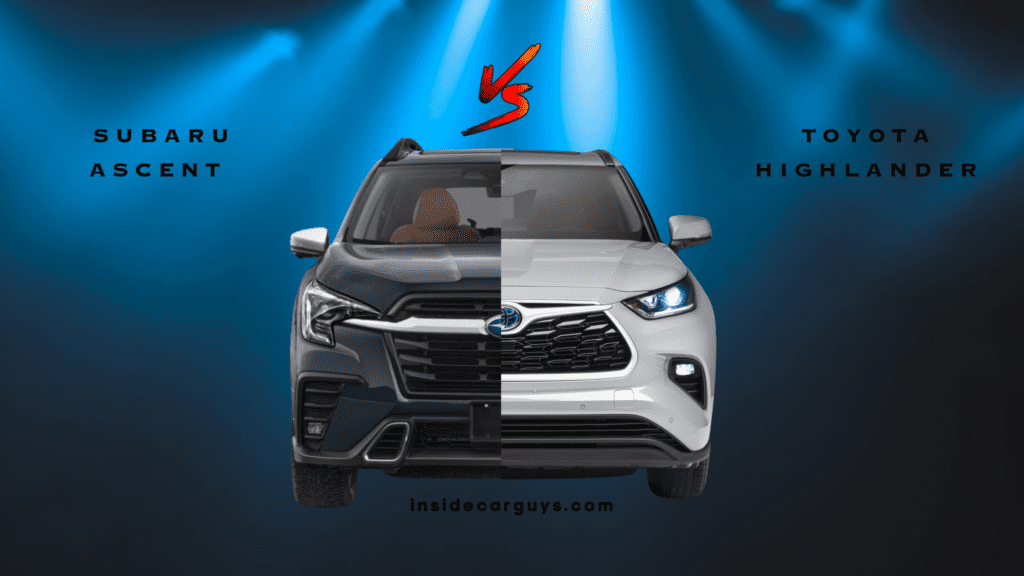The midsize SUV segment has become increasingly competitive, with numerous contenders vying for the top spot. Among these vehicles, the 2023 Subaru Ascent and Toyota Highlander stand out as popular choices for families and adventurers alike. Both SUVs have a lot to offer in terms of design, performance, and features, but determining which one is the right fit for you can be challenging.
In this comprehensive comparison, we’ll delve into the strengths and weaknesses of each model to help you make an informed decision.
Exterior Design:
The 2023 Subaru Ascent and Toyota Highlander boast unique yet appealing exterior designs. Both SUVs feature bold, aggressive lines and modern touches that make them stand out in a crowded market.
The Subaru Ascent has a rugged yet refined look, with standard LED headlights, prominent wheel arches, and a distinctive front grille. The Ascent’s design language echoes Subaru’s commitment to off-road capability and adventure.
On the other hand, the Toyota Highlander features a sleeker, more aerodynamic design. Its sculpted body lines and expressive LED headlights create a sense of sophistication and refinement. The Highlander’s exterior design is more family-oriented, offering a balance of style and practicality.
Interior Design:
Inside, both the 2023 Subaru Ascent and Toyota Highlander offer well-crafted and comfortable interiors with ample space for passengers and cargo.
The Ascent’s interior features high-quality materials and an ergonomic layout. The dashboard and center console are intuitive and user-friendly, with easily accessible controls. The Ascent also includes the latest Subaru Starlink infotainment system, which is compatible with both Apple CarPlay and Android Auto.
In contrast, the Highlander’s cabin has a more luxurious feel. Premium materials, soft-touch surfaces, and ambient lighting create a welcoming environment. The Highlander’s infotainment system, Toyota Entune, is equally user-friendly and supports both Apple CarPlay and Android Auto.
Seating:
When it comes to seating, both the Subaru Ascent and Toyota Highlander can accommodate up to eight passengers. However, there are some differences in terms of seating configuration and comfort.
The Ascent offers comfortable and supportive seats, with standard cloth upholstery or available leather. It also offers second-row captain’s chairs, reducing seating capacity to seven but increasing comfort for second-row passengers. Additionally, the Ascent provides ample headroom and legroom in all three rows.
The Highlander, while also offering comfortable seating, has slightly less headroom and legroom in the third row compared to the Ascent. Like the Ascent, the Highlander can be configured with second-row captain’s chairs for added comfort. Both vehicles offer heated and ventilated front seats, as well as heated second-row seats on higher trims.
Storage:
When it comes to storage space, both SUVs provide generous cargo capacity.
The 2023 Subaru Ascent offers 17.8 cubic feet of cargo space behind the third row, 47.5 cubic feet behind the second row, and 86.5 cubic feet with both rows folded down. Additionally, the Ascent features several small storage compartments throughout the cabin for added convenience.
The Toyota Highlander offers slightly less cargo space, with 16 cubic feet behind the third row, 48.4 cubic feet behind the second row, and 84.3 cubic feet with both rows folded down. Like the Ascent, the Highlander has various storage compartments throughout its cabin.
Performance:
Both the 2023 Subaru Ascent and Toyota Highlander deliver impressive performance, with each vehicle offering its own set of advantages.
The Ascent comes equipped with a 2.4-liter turbocharged four-cylinder engine that produces 260 horsepower and 277 lb-ft of torque. Paired with a continuously variable transmission (CVT), the Ascent offers smooth and responsive acceleration. Additionally, Subaru’s signature Symmetrical All-Wheel Drive comes standard on all Ascent models, providing excellent traction and handling in various road conditions.
The Toyota Highlander is powered by a 3.5-liter V6 engine that generates 295 horsepower and 263 lb-ft of torque. This engine is mated to an eight-speed automatic transmission, ensuring quick and smooth gear shifts. The Highlander comes standard with front-wheel drive, with all-wheel drive available as an option.
While the Highlander’s engine produces more horsepower, the Ascent’s standard all-wheel drive and turbocharged engine make for a more well-rounded driving experience.
Fuel Efficiency:
When it comes to fuel efficiency, both the 2023 Subaru Ascent and Toyota Highlander offer competitive numbers in their respective segments.
The Ascent achieves an EPA-estimated 21 mpg in the city and 27 mpg on the highway. Its turbocharged engine and CVT contribute to its respectable fuel economy figures.
The Highlander, with its standard front-wheel drive configuration, returns an EPA-estimated 21 mpg in the city and 29 mpg on the highway. Opting for the all-wheel-drive system results in slightly lower fuel efficiency numbers.
Safety:
Both the Subaru Ascent and Toyota Highlander are equipped with advanced safety features designed to protect passengers and help drivers avoid accidents.
The 2023 Subaru Ascent comes standard with the EyeSight Driver Assist Technology suite, which includes features such as adaptive cruise control, lane departure warning, lane-keep assist, and pre-collision braking.
The Toyota Highlander includes Toyota Safety Sense 2.5+, a suite of safety features that consists of adaptive cruise control, lane departure warning, lane tracing assist, a pre-collision system with pedestrian detection, and automatic high beams.
Trim Levels:
The 2023 Subaru Ascent is available in four trim levels: Base, Premium, Limited, and Touring. Each trim offers an increasing level of standard features and available options, allowing buyers to choose the configuration that best suits their needs and budget.
The Toyota Highlander is offered in six trim levels: L, LE, XLE, XSE, Limited, and Platinum. Like the Ascent, each Highlander trim level includes a range of standard features and options, enabling buyers to find their ideal vehicle configuration.
Pricing:
The 2023 Subaru Ascent has a starting MSRP of around $33,000 for the Base trim, while the top-of-the-line Touring trim begins at approximately $46,000. With various options and packages available, the Ascent offers a competitive price point within the midsize SUV segment.
The Toyota Highlander starts at a slightly higher price point, with the base L trim having an MSRP of around $35,000. The range-topping Platinum trim starts at about $48,000. While the Highlander’s pricing is somewhat higher than the Ascent’s, it remains competitive among other three-row SUVs on the market.
Key Differences:
Exterior Design:
The Ascent features a rugged, off-road-oriented design with prominent wheel arches and a distinctive front grille, which reflects Subaru’s commitment to adventure and capability. In contrast, the Highlander showcases a sleeker, more family-focused appearance with sculpted body lines and a more aerodynamic profile, striking a balance between style and practicality.
Drivetrain:
Subaru’s Symmetrical All-Wheel Drive comes standard on all Ascent models, providing excellent traction and handling in various road conditions. This feature makes the Ascent particularly appealing to those who often drive in challenging weather or off-road situations. Meanwhile, the Highlander offers front-wheel drive as standard, with all-wheel drive available as an option, catering to a wider range of driver preferences.
Engine and Transmission:
The Ascent is equipped with a 2.4-liter turbocharged four-cylinder engine that produces 260 horsepower and 277 lb-ft of torque, paired with a continuously variable transmission (CVT) for smooth and responsive acceleration. On the other hand, the Highlander features a 3.5-liter V6 engine that generates 295 horsepower and 263 lb-ft of torque, mated to an eight-speed automatic transmission for quick and seamless gear shifts. While the Highlander’s engine offers more horsepower, the Ascent’s turbocharged engine and standard all-wheel drive create a well-rounded driving experience.
Seating Space:
Both SUVs can accommodate up to eight passengers, but the Ascent offers slightly more headroom and legroom in the third row compared to the Highlander. This difference could be a deciding factor for families who frequently use the third-row seating.
Cargo Capacity:
The Ascent provides marginally more cargo space, with 17.8 cu ft behind the third row, 47.5 cu ft behind the second row, and 86.5 cu ft with both rows folded down. In comparison, the Highlander offers 16 cu ft behind the third row, 48.4 cu ft behind the second row, and 84.3 cu ft with both rows folded down. Although the difference is small, it might be significant for those who need extra storage for road trips, outdoor adventures, or moving larger items.
Fuel Efficiency:
The Highlander boasts slightly better fuel efficiency on the highway with its front-wheel-drive configuration, achieving an EPA-estimated 29 mpg, while the Ascent has an EPA-estimated 27 mpg. For drivers who spend a significant amount of time on the highway, the Highlander may offer long-term fuel savings.
Safety Suites:
Both vehicles come equipped with advanced safety features designed to protect passengers and assist drivers in avoiding accidents. The Ascent comes with the EyeSight Driver Assist Technology suite, while the Highlander is equipped with Toyota Safety Sense 2.5+. Although the features in each suite are similar, drivers may find one system more intuitive or preferable over the other based on personal experience.
Trim Levels:
The Ascent is available in four trim levels: Base, Premium, Limited, and Touring. The Highlander offers a wider range of options with six trim levels: L, LE, XLE, XSE, Limited, and Platinum. Depending on your preferences and budget, the additional trim levels offered by the Highlander may provide a more customized experience.
Pricing:
The Ascent has a lower starting price point at around $33,000 for the Base trim compared to the Highlander’s base L trim, which starts at around $35,000. This price difference may be a determining factor for buyers who are working within a specific budget or looking for the best
Conclusion:
After comparing the 2023 Subaru Ascent and Toyota Highlander across various categories, it’s evident that both SUVs have much to offer potential buyers. While the Ascent appeals to those who prefer a rugged design and standard all-wheel drive, the Highlander caters to drivers who appreciate a more refined exterior and slightly better fuel efficiency. Each vehicle’s unique set of features and capabilities makes it a strong contender in the midsize SUV market. Ultimately, your choice between the Ascent and Highlander will depend on your individual needs, preferences, and budget. Rest assured that whichever vehicle you choose, you’ll be investing in a reliable and versatile SUV that’s designed to handle the demands of modern life.
Features Breakdown
2023 Subaru Ascent:
- Exterior Design:
- Rugged yet refined look
- Standard LED headlights
- Distinctive front grille
- Interior Design:
- High-quality materials
- Ergonomic layout
- Subaru Starlink infotainment system with Apple CarPlay and Android Auto compatibility
- Seating:
- Up to 8 passengers
- Optional second-row captain’s chairs
- Ample headroom and legroom in all three rows
- Storage:
- 17.8 cu ft behind the third row
- 47.5 cu ft behind the second row
- 86.5 cu ft with both rows folded down
- Performance:
- 2.4-liter turbocharged four-cylinder engine (260 hp and 277 lb-ft of torque)
- Continuously variable transmission (CVT)
- Standard Symmetrical All-Wheel Drive
- Fuel Efficiency:
- EPA-estimated 21 mpg city and 27 mpg highway
- Safety:
- EyeSight Driver Assist Technology suite
- High safety ratings from IIHS and NHTSA
- Trim Levels:
- Base, Premium, Limited, and Touring
- Pricing:
- Starting MSRP of around $33,000 for the Base trim
- Top-of-the-line Touring trim starts at approximately $46,000
Toyota Highlander:
- Exterior Design:
- Sleek, aerodynamic design
- Sculpted body lines
- Expressive LED headlights
- Interior Design:
- Luxurious feel
- Premium materials and soft-touch surfaces
- Toyota Entune infotainment system with Apple CarPlay and Android Auto compatibility
- Seating:
- Up to 8 passengers
- Optional second-row captain’s chairs
- Slightly less headroom and legroom in the third row compared to the Ascent
- Storage:
- 16 cu ft behind the third row
- 48.4 cu ft behind the second row
- 84.3 cu ft with both rows folded down
- Performance:
- 3.5-liter V6 engine (295 hp and 263 lb-ft of torque)
- Eight-speed automatic transmission
- Standard front-wheel drive, optional all-wheel drive
- Fuel Efficiency:
- EPA-estimated 21 mpg city and 29 mpg highway (FWD configuration)
- Safety:
- Toyota Safety Sense 2.5+ suite
- High safety ratings from IIHS and NHTSA
- Trim Levels:
- L, LE, XLE, XSE, Limited, and Platinum
- Pricing:
- Starting MSRP of around $35,000 for the L trim
- Top-of-the-line Platinum trim starts at about $48,000





